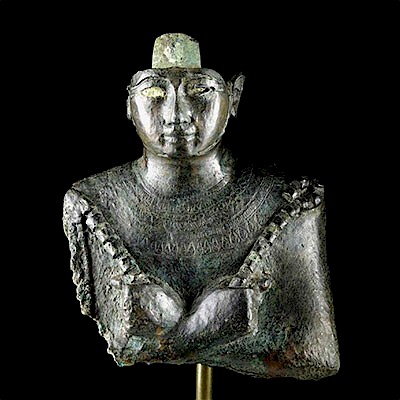Roman Painted Wall Fresco with Pheasant
Lot 46e
About Seller
Artemis Fine Arts
686 S Taylor Ave, Ste 106
Louisville, CO 80027
United States
Selling antiquities, ancient and ethnographic art online since 1993, Artemis Gallery specializes in Classical Antiquities (Egyptian, Greek, Roman, Near Eastern), Asian, Pre-Columbian, African / Tribal / Oceanographic art. Our extensive inventory includes pottery, stone, metal, wood, glass and textil...Read more
Estimate:
$12,000 - $18,000
Absentee vs Live bid
Two ways to bid:
- Leave a max absentee bid and the platform will bid on your behalf up to your maximum bid during the live auction.
- Bid live during the auction and your bids will be submitted real-time to the auctioneer.
Bid Increments
| Price | Bid Increment |
|---|---|
| $0 | $25 |
| $300 | $50 |
| $1,000 | $100 |
| $2,000 | $250 |
| $5,000 | $500 |
| $10,000 | $1,000 |
| $20,000 | $2,500 |
| $50,000 | $5,000 |
| $100,000 | $10,000 |
| $200,000 | $20,000 |
About Auction
By Artemis Fine Arts
May 22, 2019
Set Reminder
2019-05-22 10:00:00
2019-05-22 10:00:00
America/New_York
Bidsquare
Bidsquare : Exceptional Day 1: Antiquities Asian Fine Art
https://www.bidsquare.com/auctions/artemis-gallery/exceptional-day-1-antiquities-asian-fine-art-4129
Day 1 of an important 2-day auction featuring exceptional art from around the world - Egyptian, Greek, Etruscan, Roman, Viking, Russian, Near Eastern; Asian Art from China, Japan, Thailand, Vietnam, Burma, India; Fine Art from the 17th century to present. Artemis Fine Arts info@artemisfinearts.com
Day 1 of an important 2-day auction featuring exceptional art from around the world - Egyptian, Greek, Etruscan, Roman, Viking, Russian, Near Eastern; Asian Art from China, Japan, Thailand, Vietnam, Burma, India; Fine Art from the 17th century to present. Artemis Fine Arts info@artemisfinearts.com
- Lot Description
Roman, Imperial Period, ca. 1st century CE. Wow! A stunning fragment of a wall fresco with a grey background, a colorful horizontal band, and a bird - probably a pheasant, a bird beloved by the Romans - perched atop the horizontal band. The band has white borders, with a deep, wine red background, white-delineated repeated triangles, and thick pale yellow wavy dashes that look like abstract birds in flight at the center of each triangle. The bird has a pale blue-grey body with wonderful darker grey, creamy white, and red details creating a speckled appearance on the feathers and a lifelike face. Long legs extend down from the back of the bird's body, ending in three long toes that rest against and dangle over the white upper border. Size of fragment: 11" W x 13.25" H (27.9 cm x 33.7 cm); size of frame: 14.2" W x 16" H (36.1 cm x 40.6 cm)
The pheasant was an important bird for the Romans, who probably imported them from Asia to southern Europe via Greece and who then spread them throughout the Roman Empire. Roman officers bred the birds for the table but also admired their beauty. This painting would have graced an interior wall of a Roman building, which we know - mainly from Pompeii and Herculaneum - were sumptuously decorated with colorful artwork, frequently covering not just the walls but also the ceilings! They were made by coating the wall with several layers of mortar, then polishing the surface, and adding bright pigment. Interestingly, it seems that Romans sometimes preferred darker, earthier colors - like the grey background here. The beautiful bird here calls to mind one of the most surviving examples of Roman wall painting: the gardens of Livia's Villa, Rome.
Provenance: private East Coast, USA collection
All items legal to buy/sell under U.S. Statute covering cultural patrimony Code 2600, CHAPTER 14, and are guaranteed to be as described or your money back.
A Certificate of Authenticity will accompany all winning bids.
We ship worldwide and handle all shipping in-house for your convenience.
#146817Restored in two areas - one in upper right (facing) and one on lower left. Repaired from what looks like three pieces. Small areas of overpaint along the restored area of the horizontal band. Light deposits on surface. Set into a modern matrix with a metal frame to protect the back.Condition
- Shipping Info
-
All shipping is handled in-house for your convenience. Your invoice from Artemis Gallery will include shipping calculation instructions. If in doubt, please inquire BEFORE bidding for estimated shipping costs for individual items.
-
- Buyer's Premium



 EUR
EUR CAD
CAD AUD
AUD GBP
GBP MXN
MXN HKD
HKD CNY
CNY MYR
MYR SEK
SEK SGD
SGD CHF
CHF THB
THB















